
Not all machines are born equal, in particular not when it comes to harp space, or the opening under the arm of the machine.
Large projects like quilts, soft furnishings or coats can become very cumbersome if your machine’s harp space is too small. Just try stuffing a long imitation bear fur coat under the arm, you’ll see what I mean.

The harp space is the space under the arm of the machine. I measure the distance between the needle and the column, and the height of the arm, then multiply the two to get the harp space. It is approximate, of course, but still gives a good idea.

On machines that have a curvature in their main column, I try to measure to the column proper, not to the point where the column meets the bed. All measurements are rounded, otherwise it is getting too complicated!
For projects with fairly thin materials, arm height is not that important. So here it’s not so much the harp space that counts, but rather the needle to column distance.
- Summary
- Full size machines
- Oversized machines
- 3/4 size machines
- 1/2 size machines
- Even smaller machines
I keep updating this post with new measurements for more and more machines. Send me yours and I’ll add them to the list! 🙂
Proper long arm sewing machines exist of course, but cost aside, would you really want a 30″ long machine in your sewing room? In particular if that sewing room is really your sitting room and you’re sewing on your dining table? Ah, may be not then. Of course smaller long arm machines also exist, but they are usually very expensive. And I still find them too large.
In my experience, all you need for that imitation bear fur coat, is just a little extra space, just a few square inches to ease the work.
I’ve had (ahem, have) quite a few machines, and some small ones seem to be more “spacious” than other large ones. Weird. So here is a list of some machine types with their bed and harp sizes, see for yourself.
Summary
- Largest harp space – 57.75 sq. inch: White Rotary Tailoring machine, bed length 16.25″ plus access to the bobbin.
- Largest harp space in a full size machine – 45.4 sq. inch: Singer 27/127, bed length 14.5″.
- Second largest harp space – 44 sq. inch: Singer 66 and 201, Jones Medium CS and Jones Spool, bed length 14.5″.
- Largest harp space in a small machine – 32.5 sq. inch: Singer 28/128 and similar German machines, bed length 12″.
- Free arm machines have a smaller harp space than flat bed machines of the same size.
Full size machines
These machines have the same bed size, but arm length and height varies because of the different mechanism inside.
Bed length a around 14.5″.
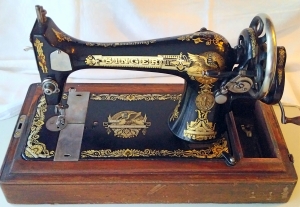
Singer 27/127, vibrating shuttle, straight stitch: needle to column 8.25″, arm height 5.5″, harp space 45.4 sq. inch.

Singer 66 and 201, Jones Spool, side-facing hooks*, Jones Medium CS, vibrating shuttle, straight stitch: needle to column 8″, arm height 5.5″, harp space 44 sq. inch.
*Singer 66: horizontal oscillator, Singer 201: horizontal rotary, Jones Spool: vertical rotary.

Adler 87, side-facing vertical rotary, straight stitch and zig-zag: needle to column 7.75″, arm height 4.5″, harp space 35 sq. inch.
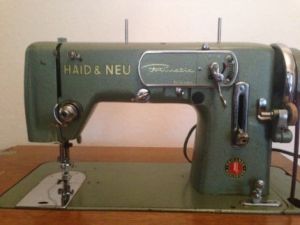
Haid & Neu Primatic, forward-facing vertical oscillator, zig-zag with external cams: needle to column 7.5″, arm height 4.5″, harp space 34 sq. inch.
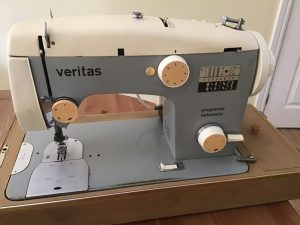
Textima Veritas 8014, forward-facing vertical rotary, zig-zag with built-in fancy stitches: needle to column 7.125″, arm height 4.25″, harp space 30 sq. inch.

Vigorelli Maxi 3000, forward-facing vertical rotary, zig-zag with built-in fancy stitches and lateral needle plate movement for very wide ribbon embroidery: needle to column 7.125″ on straight stitch, arm height 4.25″, harp space 30 sq. inch.

Singer 15 a.k.a. Central Bobbin, side-facing vertical oscillator, straight stitch: needle to column 7″, arm height 5″, harp space 35 sq. inch.

Free arm Lada T132, forward-facing rotary, zig-zag with external cams: needle to column 7″, arm height 4.5″, harp space 31.5 sq. inch.

New Home 500 series by Janome, side-facing vertical oscillator, zig-zag with external cams: needle to column 6.75″, arm height 4.5″, harp space 30.3 sq. inch.
Modern multi-stitch, forward-facing hooks, zig-zag with built-in cams: needle to column 6″, arm height 4.5″, harp space 27 sq. inch.
Oversized machines
These are larger than full size, thus compensating for the wider column and arm.
Bed length between 15.5″ and 16.5″.

White Tailoring Rotary, side-facing vertical rotary hook, straight stitch: bed length 16.25″ plus access to the bobbin, needle to column 10.5″, arm height 5.5″, harp space 57.75 sq. inch.

White Family Rotary, side-facing vertical rotary hook, straight stitch: bed length 14.5″, needle to column 8.8″, arm height 5.5″, harp space 48.4 sq. inch.
This machine has such a large needle to column distance because here access to bobbin is done from the side, outside of the bed. This works well in a special table as in the photo, but won’t work in a case, unless the case has an extension to the left to accommodate for the bobbin access, effectively extending bed length. This is why this machine is listed here under oversized machines and not under full size machines, even though its bed size is 14.5″.

Frister+Rossmann 800 series, forward-facing vertical oscillator, zig-zag and stretch with built-in and external cams: bed length 15.5″, needle to column 7.5″, arm height 4.5″, harp space 34 sq. inch.

Singer 317K and 401G series, forward facing horizontal hook, zig-zag with external cams: bed length 16.5″, needle to column 7.25″, arm height 4.5″, harp space 32.5 sq. inch.

Free arm Frister+Rossmann 500 series, forward-facing vertical oscillator, zig-zag and stretch with external cams: bed length 16″, needle to column 7″, arm height 4.5″, harp space 31.5 sq. inch.

Kenmore 158.1756, forward-facing vertical oscillator, zig-zag and stretch with built-in and external cams: bed length 16.5″, needle to column 7″, arm height 4.5″, harp space 31.5 sq. inch.
3/4 size machines
These are scaled down versions of some of the full sized machines.
Bed length 12″.
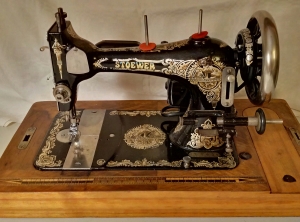
Singer 28/128, vibrating shuttle, straight stitch: like Singer 27/127, but smaller. Needle to column 6.5″, arm height 5″, harp space 32.5 sq. inch.

Jones Family CS, vibrating shuttle, straight stitch: like Jones Medium CS, but smaller. Needle to column 7″, arm height 4.5″, harp space 31.5 sq. inch.

Singer 98 and 99, side-facing horizontal oscillator, straight stitch: like Singer 66, but smaller. Needle to column 6″, arm height 4.5″, harp space 27 sq. inch.
1/2 size machines
These are scaled down even further! Baby machines. 🙂
Bed length 9.5″.

Singer 221 Featherweight, side-facing vertical rotary, straight stitch. Needle to column 5″, arm height 4″, harp space 20 sq. inch.
There is also a 1/2 size version of Singer 15, a side-facing vertical oscillator, made in Japan after WWII, but I’ve never had one of those.
Even smaller machines
These are properly small! Yet no toys.
Bed length 7″.

Japanese Micro Elite, side-facing vertical rotary, straight stitch. Needle to column 3.75″, arm height 2.75″, harp space 10.3 sq. inch.
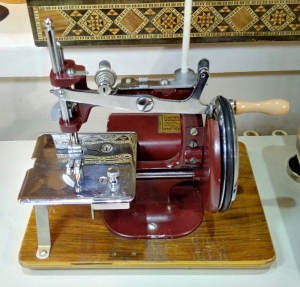
Essex chain stitch machine. Needle to column 3.5″, arm height 2.5″, harp space 8.75 sq. inch.
Gasp. Your vintage sewing machines are breathtaking!
LikeLike
🙂 Vintage machines are generally breathtaking. 🙂 And they sew beautifully too, which is probably why you can’t just have one. Like cats.
LikeLiked by 2 people
I agree. I got a Domestic fiddle base treadle, because of the harp space, and am looking to treadle my 31-15 for the same reason. I have the original table and motor, but I don’t need fast. I need space and control. Wosre harp space ever is the newer plastic machines. The newest in my harem is my Viking Enerald 183. Many features, but tiny throat.
LikeLiked by 1 person
Yes, all those features require more shafts, gears, cams and/or electronics, and it all has to sit somewhere. This makes the column and the arm thick and heavy, eating up harp space. The only solution is to expand outwards making the machine larger in length and height. But that can quickly become too large to pass as domestic!
LikeLiked by 1 person
Please forgive my naivety, but what does arm hight mean?
LikeLike
Hi Tiffany, arm height is the vertical distance between the bed and the arm. Basically we are measuring the space to the right of the needle as it is sometimes necessary to fit your work through that – think of stitching in the middle of the quilt. That space is called the harp space, and it is bound by the bed below, the needle on the left, the column on the right and the arm above. I should add a picture of this! Thank you for your question. 🙂
LikeLike
The White Family Rotary are fairly tall in the arm. I have one of their immediate successors which is badged, but identical to models 41 and 43 in shape (and, sadly, brown crinkle paint–some of us cannot be trusted to maintain shellac to your standard) with needle to pillar distance of 8″, bed to arm height of 6″, and scorching hot lamp on the front of the arm. (Note to self: unscrew & measure silly thing, replace with LED bulb.)
LikeLike
Yes, replace that lamp. 🙂 And I don’t maintain the shellac – I varnish over it. 😉 That is an impressively high arm, I must say! We don’t get a lot of White machines in the UK, and I’ve never seen the Rotary in the flesh here. We do get an occasional New Home or a White Peerless, and of course the Wheeler&Wilson No. 9, a.k.a. Jones Spool, but I don’t think that either of them are 6″ tall under the arm (my Jones Spool is just like a Singer 66 in harp size).
LikeLike
Well, Elena, I was forced to do it. I first measured an ordinary White Family Rotary from 1916 and then I measured my 1913 White Rotary Tailoring Machine. The White Family Rotary has a bed length of 14.25 inches not including the hand hole cover which juts out from the bed. The distance from needle to pillar is a smidge over
8 7/8″ and the bed to the underside of the arm is 5.5″ for an overall underarm space of 49.5 square inches. The White Rotary Tailoring Machine has a bed length of 16.25″ NOT counting the huge wooden hand hole cover. The distance from needle to pillar is 10.5″ and from bed to underarm is 5.5″ for a total of 57.75 square inches.
Two great machines for large projects.
Best wishes!
Katie Farmerr
The White Sewing Machine Research Project
LikeLike
Fantastic, Katie, thank you very much! I’m adding it to the list! These machines are larger than Singers.
LikeLike
The White Family Rotary is a standard size White Rotary for the time. The White Rotary Tailoring machine is basically a White FR with two inches of length added overall, a very large hand hole cover, and a knee operated presser bar lift. It was offered in two versions: the 20 and the 21. The 21 has no knee lift but it does have
a coffin top and a double feed.
The White Family Rotary had an “attachment” in order to convert it to chain stitch. The kit consists of a change of shuttle race and needle plate. I have not tried to use the kit with the Tailoring Machine as yet. But it is definitely of interest. My Tailoring Machine is a 20.
White did not really make industrial machines. The White Rotary Tailoring Machine was made for home business, not production lines. It was offered from 1903 through 1931. Only about 110,300 were made in that time and it is extremely unusual to see one anywhere.
Katie Farmer
The White Sewing Machine Research Project
LikeLike
Very interesting, Katie, thank you! We see tailoring machines from other makes here too, and like with White, they are basically domestic machines with extra robustness or size, although not as big as the White!
I am also very interested in that chain stitch attachment you mentioned. Is it similar to the Willcox & Gibbs “propeller” hook? Could you please send me some photos? Thank you!
LikeLike
Great blog! Thank you!
LikeLike
Glad you like it! 🙂
LikeLike
This was a wonderful read (sorry I am late to the party lol) but I too have wondered about the size difference… I have Singer models 127, 15, and a 66 and always just assumed the 66 was the largest and the 201 (which i don’t currently own) would be the biggest of them all~ imagine my surprise that my humble 127 took first prize! (She is a treadle, by the way!) Thanks again for a great article!
LikeLike
Yes, I was quite surprised at that myself when I did the measurements. 😊 Vibrating shuttle machines are very good for harp space, while 66 and 201 are exactly the same. 😉 And in fact the new style 201 has a smaller harp space because its column and arm are fashionably thick and chunky, and filled with empty space… Hehe.
LikeLiked by 1 person
Hello Elena
I did not discover until now, that you did this research. I tried to collect some of the same information, and I got a smaller list, but with a few other machines. I use mm, so I home this is in order:
https://drive.google.com/uc?id=1Y2I1tH4-hL4PIdX6mTQSUooEUo0JDjDq
/Viggo
LikeLike